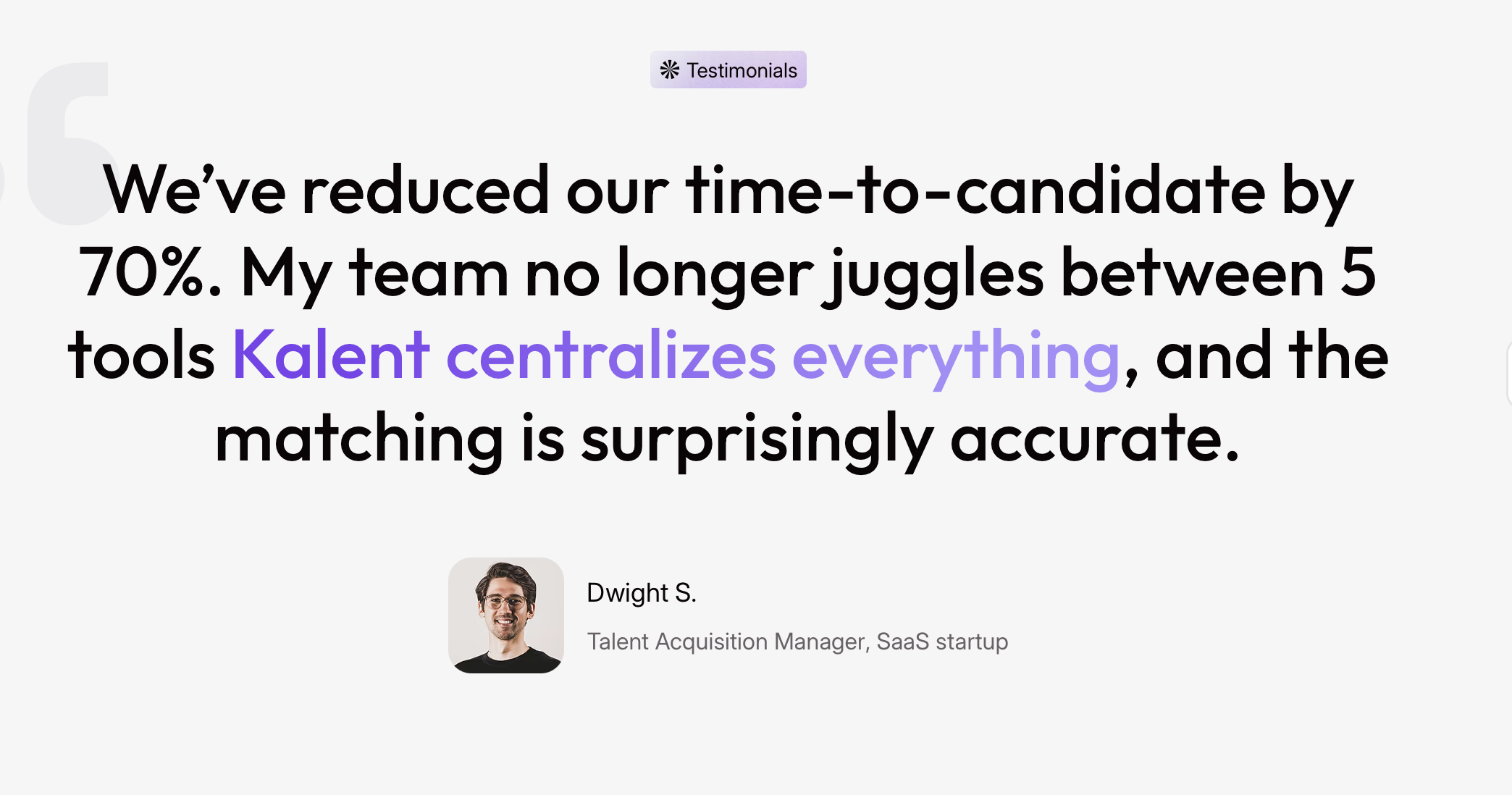What Does an Administrative Assistant Job Description Look Like in 2025?
The administrative assistant job description in 2025 is no longer about clerical tasks it’s about tech fluency, emotional intelligence, and adaptability. Kalent helps recruiters craft detailed, modern job descriptions that reflect these shifts, connect with qualified candidates, and deliver up to 5x better reply rates through contextual AI sourcing.
What Does an Administrative Assistant Job Description Look Like in 2025?
In 2025, administrative assistant job descriptions are no longer about typing speed or answering phones – or even simple customer service skills. The modern administrator must be tech-savvy, flexible and able to manage schedules across time zones and regions.
Often, they’re responsible for keeping data flowing between teams, automating tasks and overseeing processes to check for errors. Essentially, it’s their job to make sure nothing falls through the cracks, all while juggling multiple tools.
A good administrative assistant job description reflects this shift, showing what the role looks like in a mostly digitized, fast-moving workplace. When done right, the job description provides recruiters and candidates with a unique window into how a company works and what kind of person thrives there.
In this article, we’ll discuss what makes a good administrative assistant job description and how to write one. We’ll also share how our AI recruitment tool, Kalent, can streamline this entire process and help you achieve 5x higher response rates from better, more qualified candidates.
The Modern Administrator: More Than Just Office Support
The first rule of writing a good administrative assistant job description is to make sure it reflects the modern workforce. It’s no good rehashing an old document you used three years ago – the team, tech and role itself are likely to have changed significantly since then.
These days, administrative assistants sit right in the middle of everything. They coordinate meetings, manage shared calendars, support executives, help HR with onboarding and make sure projects stay on schedule. In remote or hybrid teams, they’re often the people holding it all together behind the scenes.
In 2025, automation now takes care of a lot of the repetitive work that once kept administrators chained to their desks, such as summarizing meetings, prioritizing emails and generating reports. This frees admins up to serve more of an oversight and management role – although, of course, this will look different for every company.
In tech, an administrator might manage sprint planning and OKR tracking. In healthcare, they could be dealing with patient scheduling and compliance paperwork, while in finance, it’s often board packs and confidential reports that make up their workday.
The common thread is that administrators are responsible for keeping the business moving. Increasingly, success is measured not by how many tasks they complete, but by how well the team operates because of them.
So how can you make sure your administrative assistant job description reflects this shift?

Essential Skills for Your Administrative Assistant Job Description
If you look at almost any current administrative assistant job description in 2025, the one thing that stands out is that technical fluency is no longer optional.
These days, administrators are expected to handle Microsoft 365 or Google Workspace as easily as they once managed filing systems. They may also use Notion or Asana to keep projects on track, CRMs like Salesforce or HubSpot to manage data and automation tools to handle recurring tasks. Some admins even use AI scheduling assistants or data clean-up tools.
However, the best administrative assistants bring more to the role than technical acumen. The right candidate should also be emotionally intelligent, adaptable to change and able to prioritize tasks under pressure. It’s also important that they understand digital privacy, can spot trends in data and learn to collaborate with AI tools.
A strong administrative assistant job description should highlight the need for someone with both technical ability and people skills – able to communicate well across teams and also juggle multiple different tools. So how do you go about conveying this?
The Difference Between a Weak and Strong Job Description
A strong administrative assistant job description is concise, specific and tells you all the key information you need to know about the role, the company and the sort of person they’re looking to hire. Bad job descriptions use vague language, corporate jargon and sweeping generalizations that could apply to any job.
Here’s an example of a weak job description:
We’re looking for an organized, efficient Administrative Assistant for a busy office. Must be detail-oriented, friendly and able to work well with others.
This tells you almost nothing about who the company is or what the role looks like day-to-day. There’s no sense of the company, the team or how success is measured. It could have been written last week, or ten years ago, for any company in any industry.
Here’s a stronger example:
We’re looking for an Administrative Assistant for our remote-first product team. On a day-to-day basis, you’ll coordinate calendars across multiple time zones, manage sprint logistics in Notion and produce weekly reports from Jira data. You’ll also support our VP of Product and two Directors to keep projects on schedule.
The second version instantly paints a more intricate picture of the team, the role and the company's expectations.
For recruiters, this extra context makes all the difference. It helps identify candidates who’ve handled similar challenges and allows you to craft outreach that actually resonates.

How Kalent Helps You Write Better Job Descriptions
Want to write a better administrative assistant job description but don’t have the time because you’re so bogged down by recruitment admin?
Here’s how Kalent can help…
All you need to do is upload your job posting, and Kalent will scan it, pull out the relevant context and match it with candidates who actually fit the job description – no more basic keyword matches.
Kalent then helps you write personalized outreach across LinkedIn, email, SMS and WhatsApp that sounds personal and compelling. No boring templated messages!
With Kalent, recruiters see 5x better reply rates than the industry standard, but it’s not just about getting more messages but better ones, from candidates who actually fit the job description and have the experience you’re looking for.
There’s a tangible payoff to all this. Recruiters using Kalent’s contextual sourcing tools tend to make more placements per person and spend less time searching. Agencies often report a lift in annual revenue after switching from generic sourcing to context-driven outreach.
For roles like administrative assistants (which are generally high volume but often low engagement), the improvement is even more noticeable.
So, instead of wasting hours messaging candidates who never reply, you can focus on conversations that actually move forward. Our AI tool accelerates the research, freeing you up to focus on managing relationships and closing deals.
Kalent: Turn Your Job Descriptions into 5x Reply Rates
The evolution of the administrative assistant job description shows how fast workplaces are changing. Administrators are no longer just “support.” They’re now central to a company’s coordination, communication and culture.
For recruiters, job descriptions become more than lists of duties. They tell you who to target, how to talk to them and what will make them care about the role you’re trying to fill.
With Kalent, your next administrative assistant job description becomes the foundation for smarter, more human sourcing. Book a demo today to see how it works.





